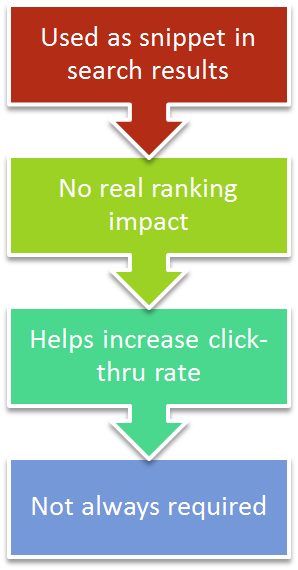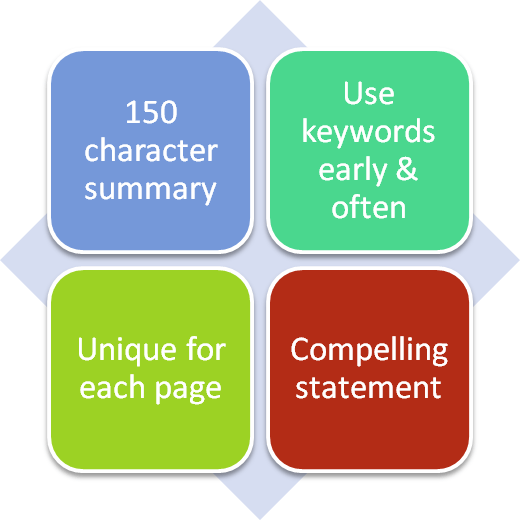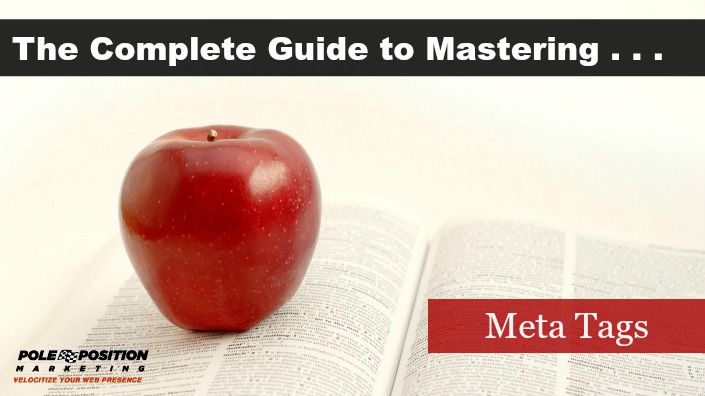Editor’s Note: This article was originally published on 11/8/2012 and updated 7/30/2015
If you were ever going to tell a “back in the day” story about SEO, it would have to include a discussion of meta tags. Long before links were built, before content was king and before social was sharable, meta tags were optimized. Meta tag optimization is the original SEO.
But gone are the days when throwing long lists of keywords into a meta tag could move your site to the first page of Alta Vista, Excite or Webcrawler. For that matter, gone are Alta Vista, Excite and WebCrawler. Today’s SEO isn’t the SEO of, well, your slightly older sibling. While there is still some value to optimizing your meta tags, it just isn’t what it used to be.
What are Meta Tags and Where Are They Found?
There are lots of meta tags that serve a variety of purposes, but for SEO, there are really only two that matter. Strike that. There is really only one tag that matters, but we’ll cover two tags just so you can slap the idiot that tries to tell you the keyword meta tag is still relevant. But we’ll get to that later (keywords, not the slapping).
Meta Description Tag
The meta description is intended to be a short summary of the content of a web page. Where the title tag is very limited, a meta description gives you a bit more space to summarize each page. Think of your meta description as a web page’s 10-second elevator pitch -– that is,what your web page would say if it was in an elevator and someone asked what it does for a living.
The description itself is encased in the meta code, found in your page’s <head> section of your code:
<head>
<meta name="description" content="This is your page description. Be specific and succinct so your visitors know what your page is about."/>
</head>
Meta Keyword Tag
The meta keyword tag is was intended to be a way to tell the search engines which keywords your page should rank for. Imagine SEO being so easy as telling Google, “Hey, rank this page for ‘mortgage broker,'” and Google replies, “As you wish.” Back in the day, keyword meta tags were filled with long lists of keywords as “SEOs” tried to work in every possible keyword they wanted to rank for, regardless of the particular relevance for that page.
Like the meta description, the keywords are encased in the meta code, found in your page’s <head> section of your code:
<head>
<meta name="description" content="..."/>
<meta name="keywords" content="this, is, what, a, meta, keyword, tag, often, looks, like, some, people, use, commas, and, a, space, between, words, some,people,don't,use,a,comma,but,no,space,between,words, and some people use just a space without commas between words"/>
</head>
How and Where the Meta Tags Are Displayed
Meta Description Tag
The meta description tag frequently accompanies the title tag in the search engine results pages. With the page’s title generally being the clickable link, the meta description falls below that, providing additional information for the searcher. Highlighted below are two examples of meta description tags in the search results.


Google is pretty inconsistent in how, or if, it displays the meta tag in the search results. In the first image above, you can see pretty much the full description displayed. In the second example you can see what happens when the meta description is too long to fit. Google will often add additional information they feel is relevant to the searcher, though I frequently take issue with this assumption!
Meta Keyword Tag
The image below shows how searchers and visitors see your meta keyword tag:
You don’t see the keyword tag above? Makes sense, because search engines don’t see it either. It is completely ignored.
How You Benefit From Good Meta Tags

Unfortunately, neither meta description or meta keyword tags do anything to help improve your search engine rankings. Both of these tags are completely ignored when it comes to Google’s ranking algorithm. Some suggest that Bing still uses these tags, but the degree of value they add to improving your rankings is pretty minimal.
Without any ranking impact, what good are these tags? It’s all in the display. And since only the meta description tag is displayed anywhere, that means it’s the only tag that really provides you any genuine benefit.
The displayed portion of the meta description in the search results is instrumental in increasing click thru rate from the search results to your website. Think of it as the “assist” to the title tag. Where the title is shorter and can’t be as detailed, the meta description provides a bit more context for the searcher to see what information they will get on the page.
When determining which site to click on, searchers may place more importance on the meta description than the title info. Since the title is often optimized for the page’s main phrase, the meta description will provide more “long tail” context for that phrase that the title cannot be optimized for. This gives the searcher a broader perspective of the page.
Since you’ll never know how much of the meta description will be displayed in the search results (it can vary for each keyword searched), you want to maximize the first several words. Don’t miss an opportunity to get your message across by fluffing up content in the front of your meta description. Get to the point.
There are also some instances when no meta description at all will serve you better. When no meta description is available, the search engines will often resort to displaying a snippet of text that uses your keywords pulled from the page. If your page has a lot of text, say 2000+ words that covers a wider swath of content, you may be better off letting Google pull the snippet based on the search. This will increase your likelihood of the actual search terms showing up in the snippet (your meta description can’t fit them all), which increases the likelihood that the searcher will find your result relevant to their query.
How to Craft Good Meta Tags
Meta Keyword Tag
Crafting a good meta keyword tag isn’t rocket science. Since it’s a 99.9% useless tag for external search engines, you can leave it off the page all together. Putting your keywords into the meta tag is like advertising to search engines and your competitors that you’ve optimize the page for those keywords. However, since some sites use this tag for internal site search, there can be some value for including it.
Don’t waste too much time trying to figure out how best to create a keyword tag. Commas, spaces, length, context, phrases, etc., don’t really matter. As long as your internal search (and supposedly Bing) can read the words, you’re in good shape.

Meta Description Tag
Your meta description tag requires a bit more work. Remember, this (usually) shows up in the search results, so you want to make it count for clicks, even if it doesn’t count for rankings. To write a good meta description, there are a few ground rules to follow:
150 Characters: Google will display up to about 150 characters of your meta description. This is almost 60% more space than the title tag allows, giving you the opportunity to include more keywords and/or calls to action.
Use Keywords Early: Since it’s possible that your meta description will be severely truncated, you want to get your keywords as near to the front as possible. Feel free to add extended qualifiers and keyword variations throughout, as good sentence structure allows. Don’t stuff it with keywords, but instead go after some longer-tail words that might be part of any search phrase.
Unique for Each Page: If you are writing a meta description tag for each page (and you should), it should be unique. Don’t be lazy and copy/paste the same meta description from page to page. Write something that is relevant for that page only, even if the page’s content is similar to other pages. Either way, create a description that speaks to the content of the page that isn’t duplicated anywhere else.
Be Compelling: Above all else, your meta description should be a compelling statement. Use proper sentence structure rather than trying to throw in as many keywords as possible. It should read well and, ultimately, entice the visitor to want to click into your site. The better it reads, the more searchers will click, if the information matches their search intent.
While crafting a great keyword tag is impossible (like having a great appendix – ultimately it has no purpose and nobody cares if it’s there until something goes horribly awry), crafting a good meta description tag can be the difference between being noticed and getting overlooked as the searcher clicks on your competitor’s results. Crafting a good tag should take about 5 minutes per page, and it’s well worth the time.


 “Think of your meta description as a web page’s 10-second elevator pitch that is,what your web page would say if it was in an elevator and someone asked what it does for a living.” — Stoney deGeyter
“Think of your meta description as a web page’s 10-second elevator pitch that is,what your web page would say if it was in an elevator and someone asked what it does for a living.” — Stoney deGeyter
One Response to The Complete Guide to Mastering Your Meta Tags